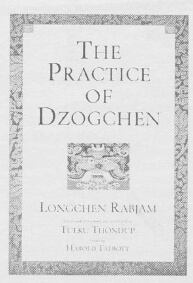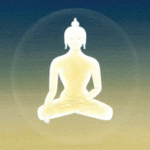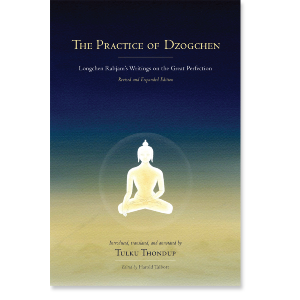| The following article is from the Summer, 2002 issue of the Snow Lion Newsletter and is for historical reference only. You can see this in context of the original newsletter here. |

"This is one of the most significant works on Tibetan Buddhism to be published in recent years, treating with grace, beauty and depth a most important subject. This is undoubtedly one of the most comprehensive works on the Nyingma to appear in English."—Glenn H. Mullin, Tibetan Review
"An invaluable guide for those who seriously wish to experience of the true nature of the mind."—Parabola Magazine
"Authoritative, comprehensive and clear. This book fills a major gap."—Matthew Kapstein, University of Chicago
Longchen Rabjam (1308-1363) is the most celebrated writer and adept of the Nyingma School of Tibetan Buddhism. His excellent writings on the view, meditation and the result in Dzogchen, and in the sutras and tantras make up the core of this book.
In his masterful introduction to the body of this work, Tulku Thondup covers the three outer and inner tantras, the three division of Atiyoga, Dzogchen and the other yanas and traditions, and last but not least—excerpts from the exemplar lives of teachers (including Longchen Rabjam) to illustrate the ways of training in Dzogchen.
Tulku Thondup Rinpoche is the author of The Healing Power of Mind (with Daniel Goleman) and Boundless Healing, and lives in Cambridge, MA.
The following is a section entitled "Twenty-seven Courses of Training in Dzogpa Chenpo" from The Practice of Dzogchen.

In The Meaning Instructions on Three Virtues of Relaxation in the Natural State of The Mind, Longchen Rabjam presents a hundred and forty-one courses of training divided into three chapters. The first chapter is on outer common teachings of Sutra, the second is on inner esoteric teachings of Tantra, and the third chapter is on the innermost resultant teachings of the Great Perfection (rDzogs Pa Chen Po). The following is an abridged translation of the third chapter, which has twenty-seven courses of training.
IDENTIFICATION (OF THE BASIS) THROUGH (UNDERSTANDING THE) VIEW
The External Apprehended Objects Are Non-Existent Emptiness
(i) The appearances are unreal reflections like the eight examples of illusion. Every aspect of the five objects, such as form, included in the phenomena of the world and beings, are mere appearances with no true existence. All the appearances which have appeared to both the pure perceptions of the Buddhas and the impure perceptions of deluded beings are the percepts of wisdom and the mind. While the appearances are appearing to both perceptions, they are appearing with no inherent existence (Rang-bZhin), like a reflection in a mirror and rainbow rays in the sky. To the pure perception of wisdom the (appearances) transcend the extremes of existing and non-existing as there are no stains of apprehender and apprehended. As there is no creating, ceasing, and changing, all are free from the characteristics of compounded phenomena, the appearances of uncompounded emptiness-form, and are totally free from conceptualizations. To the perception of the deluded mind, (the appearances) merely appear as the object of apprehension of self (bDag-'Dzin), which have fallen into the extreme (concepts) of existing or non-existing, are detached from the characteristics of uncompounded (nature), and have strengthened the habituations of adventitious and circumstantial self-perceptions. So, here, one will understand that the objects, the delusory appearances of the mind, are unreal. Various external appearances, such as white and red, are merely the percepts of rigid habits, like a dream created by the drunkenness of ignorant sleep. There is not the slightest existence (in them) as the object in the (true) meaning. Also, those appearances are not mind from the very point of their arising, because their substantial characteristics, such as color, size, and distinctions, negate the character of the mind. At the same time, they are not other than the mind, because, in addition to their being merely the delusory perceptions (of the mind), no other object has ever been established as such. The appearances to the mind are just types of experience of rigid habits continuing from beginningless time. It is like dreaming last night about a magic show one has seen yesterday. Therefore, one should think that whatever appears are appearances of non existence, and are without foundation, abiding place, natural existence, and recognizable (entity). They are merely a clear appearance of the empty nature like a dream, magical display, mirage, echo, shadowy view (Mig-Yor), water-moon (reflection), miracle, and the city of smell-eaters (a spirit world). Whatever appears, self or others, enemies or friends, countries or towns, places or houses, food or drink or wealth, and whatever one does, eating or sleeping, walking or sitting, one should train in seeing them as unreal. One should devote oneself to this training in all its aspects: the preliminary, actual, and concluding practices.
(ii) The objects, if analyzed, are emptiness. If the appearances are examined from gross to subtle down to atoms, they are partless and non-existent. So form is emptiness. (Likewise,) by examining color and recognition of sound, it (will be found to be) emptiness. By examining the form and essence of smell, it (will be found to be) emptiness. By examining the aspects of taste, they (will be found to be) emptiness. Especially, by examining the sources (sense-objects), the emptiness of touch will be reached. Although they are different in appearance, they are the same in their nature in being emptiness, so the emptiness of various objects are not separate categories. Their nature, like pure space, transcends being either separate or the same. So the nature of objective appearances is emptiness in its essence.
The Apprehender Has No Foundation and No Root
(i) The consciousnesses are self-clarity without foundation.
(There are eight consciousnesses.) The five sense-consciousnesses; arise as the five objects such as form, the mind-consciousness cognizes the general impression (of the appearing objects) and designates them as the objects, the defiled mind-consciousness is the sense of negating, accepting, hating and disliking (etc.), the mind-consciousness arises after the six consciousnesses (five senses and universal ground consciousness), ...and the consciousness of universal ground is self-clarity (Rang-gSal) and no thought and is unrelated to the objects: these are the eight or six consciousnesses. At the (very) time of (functioning of any of) those consciousnesses themselves, whatever consciousness it is, it is clear, vivid, and self-clarity with no foundations. Although they appear clear, there is no substantial entity. They are appearing without existence, like clear space and a breeze with no dust. Their clarity is present naturally like the sky without clouds. Their movements are like wind, not in distinguishable substances. From the (very) time of appearing, (the consciousnesses) as the apprehenders are self-clarity and unrecognizable. Watch them when they are arising and when they are abiding. Relax naturally and watch the manner of appearing of the apprehender. Thereby one will realize the apprehenders as having the nature of merely an appearance of clarity with no existence, emptiness with no bias, and self-clarity with no foundation.
(ii) (The subject), if analyzed, is emptiness without root.
By analyzing (whether) the self-clear, baseless mind (exists) in the external appearances, inner physical body, or intermediate movements, or if the entity of the self-dwelling mind itself (can be) recognized in (its) design, color, birth, cessation, and abiding, one will realize that its nature is non-existence, baseless and free from the extremes of either existence or non-existence. In this training the devotion to the Lama is the only important thing.


